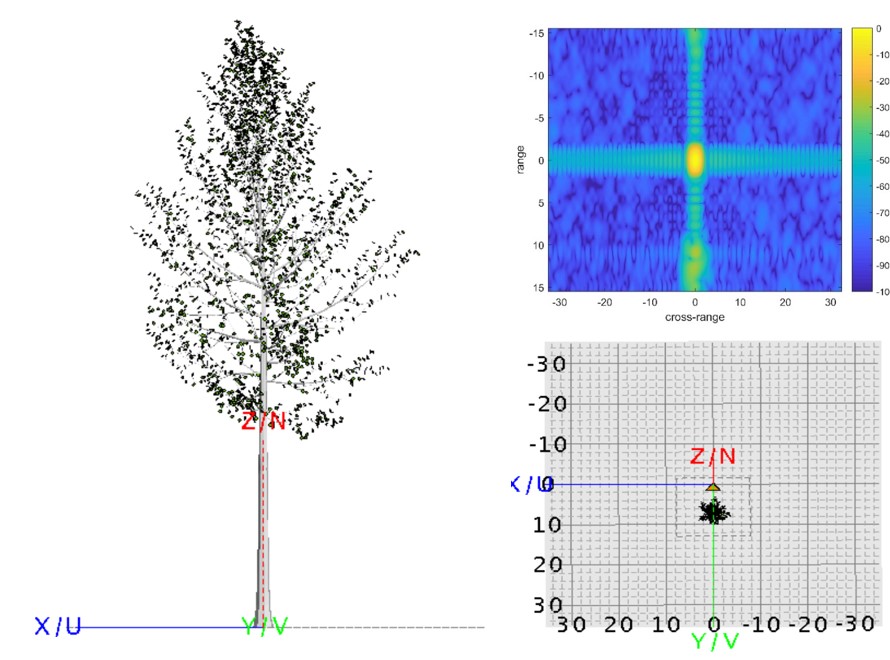The Art (and Science) of Camouflage
Using CAD, RCS, and scattering simulation to assess radar foliage penetration
As surprising as it sounds, the world’s most sophisticated radar systems can still be thwarted by a bunch of leaves and branches. Natural obstructions, especially tree cover, present a complex challenge for designers of advanced commercial and defense mapping and detection systems.

Radar cross-section (RCS) is a measure of how detectable an object is by radar. The larger the electromagnetic signature of an object, the more easily it can be detected. Designers of radar systems can use simulation technology like Altair FekoTM to assess the detectability of objects including its scattering performance, which measures how electromagnetic (EM) energy is scattered when an object is exposed to radar signals.
Synthetic aperture radar (SAR) systems use EM waveform transmissions to illuminate objects, and images are created from processing reflections or echoes. SAR transmitters are typically installed on moving airborne or satellite platforms to operate at stand-off ranges and collect terrain data measurements. The measured data, collected from multiple passes or scans is interpreted into surface terrain maps to help detect and discriminate between key landscape features, such as fault lines, bodies of water, forests and vegetation, glaciers, etc. Some of the most technical tasks include discriminating foliage in mapped terrains, identifying forest types, discerning tree heights, and detecting anomalies or hidden objects beneath foliage - termed the foliage penetration (FOPEN) problem.
Because lower frequencies in the ultra-high frequency (UHF) and very high frequency (VHF) bands have associated wavelengths that are notably larger than tree leaves and branches, their EM transmissions can easily penetrate through, making them ideal for FOPEN. However, when considering higher frequencies in the K-band (18 – 27 GHz range) and Ka-band (27 - 40 GHz range) with wavelengths on the order of millimeters, the physical dimension of most leaves, these smaller wavelengths result in greater EM wave interaction with foliage, increasing scattering and attenuation effects, and decreasing mapping performance.
Due to the increasing interest in using higher Ku-band frequencies (12-18 GHz) for FOPEN, there is a growing need to quantify the interaction of foliage with Ku-band frequencies to aid with enhanced technology support for applications in both the commercial and military domains. Overall, this important area remains largely unaddressed in the modeling realm today because of the required heavy model detail and substantial computational resources to solve these RCS simulations.

FOPEN modeling with Ku-band wave transmission
A joint study was conducted by Sandia National Laboratories, the U.S. Department of Energy, the National Nuclear Security Administration, and Altair to explore FOPEN problem on Ku-band wave transmissions. This research lays out a FOPEN modeling methodology that introduces a range of new innovations and contributions to address the phenomenology of Ku-band EM wave transmissions through moderate foliage. Highly detailed computer-aided design (CAD) tree models were created for an aspen tree and pine tree, and due to the level of detail, the models required geometry editing using the meshing tools available in Altair HyperWorksTM. The trees were imported into Altair Feko where FOPEN computational electromagnetic behaviors at L-band and Ku-band were characterized.
The preparation of the model for analysis entailed utilizing both Feko and HyperWorks and their ability to import and export common file formats. A majority of this stage was performed in HyperWorks to clean the geometry such that a meshed model of reasonable size and high quality would be obtained.


FOPEN modeling study findings
Lower frequency ranges with corresponding large wavelengths are commonly researched and implemented for FOPEN because these low frequency ranges have been proven to be effective at penetrating through dense foliage. It’s possible, however, to view this problem with a different perspective.
Instead of penetrating through the foliage, transmitting EM signals through the openings of the foliage allows opportunities for employing higher frequencies for FOPEN. The advantage in utilizing higher frequencies is that the associated smaller wavelengths provide finer scan resolutions that overall aid with foliage characterization and target detection. Additionally, higher frequency radars are generally more compact and can yield sizeable space and weight savings, making them especially useful in unmanned aerial systems (UAS).
Introductory scenes and results of the FOPEN simulations proved that there is transmission through moderate foliage at the Ku-band. These results are significant and useful to radar engineers because it establishes that penetration through foliage is viable and higher frequencies may be applicable for the appropriate foliage scene.
Techniques to discriminate targets through foliage can be developed leveraging the knowledge that transmissivity is possible at Ku-band. Also, this data gives insight to the usefulness and applicability of existing technology. For example, perhaps for SAR, a 3D technique like tomography could be useful for “seeing” below the foliage to distinguish the signatures of the target from the echoes of the foliage. Also, other radar modes like ground moving target indicator (GMTI), where target movement is detected, might be successfully employed in scenes with moderate foliage.
Want to learn more about RCS and scattering simulation for radar systems?





